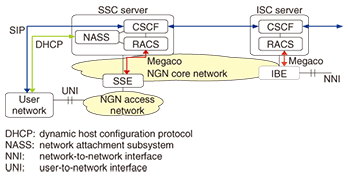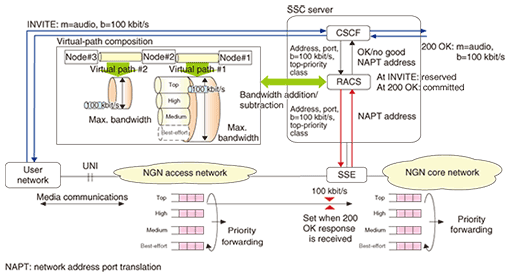 |
|||||||||||||
|
|
|||||||||||||
|
Special Feature: NGN FocusSpecial Feature: NGN Focus Vol. 7, No. 7, pp. 15–18, July 2009. https://doi.org/10.53829/ntr200907sf5 Bandwidth Management and Control Technology in the NGNAbstractThis article describes bandwidth management and control technology in the Next Generation Network (NGN). This is one of the key technologies that enable the NGN to provide a wide variety of high-quality services including Internet service provider access, retransmission of digital terrestrial broadcasts, telephony, and video on demand. With this technology, a resource and admission control function on a call control server manages the bandwidth resources within the network and guarantees communication quality by reserving the requested bandwidths for the session described in session initiation protocol messages.
1. IntroductionMost networks based on Internet protocol (IP) such as the Internet are best-effort networks, which means that when they become congested, packets may be dropped or greatly delayed and communications quality will be deteriorated. On the other hand, the Next Generation Network (NGN), which provides various network services, is designed to provide stable communication quality, for which bandwidth management and control technology [1] plays an important role. It guarantees communications quality by allocating network bandwidth resources to provide adequate communication quality for each service, taking into account the application quality, IP traffic characteristics, and network composition. 2. Network functionsTo guarantee communications quality for a variety of network services such as digital terrestrial broadcasts, telephony, and video on demand, the NGN implements a bandwidth control mechanism in cooperation with the session initiation protocol (SIP) [2]. The session control functions in the NGN are shown in Fig. 1. The transport network of the NGN consists of an access network and a core network. The former consists of optical fibers and transmission equipment that distributes those fibers to user networks, and the latter consists of high-capacity routers. The core network connects to other networks via edge routers. There are two types of edge routers: a subscriber service edge (SSE) that connects to the access network and intermediate border gateway equipment (IBE) that connects to the networks of other carriers. A user network made up of home terminals and routers connects to the SSE via the access network.
There are also two types of session control servers: a subscriber session control (SSC) server that admits subscriber sessions and an intermediate session control (ISC) server that performs relay processing. The SSC and ISC servers control the SSE and IBE, respectively, through H.248/Megaco protocol [3]. A session control server has a call session control function (CSCF) for SIP signaling and a resource and admission control subsystem (RACS) for controlling the SSE and IBE edge routers. The SSC server also has a network attachment subsystem that manages the IP address space and authenticates terminals by means of the dynamic host configuration protocol. In the NGN, these functions interact for each session request and perform appropriate processing to secure bandwidth. 3. Transport quality classesThe NGN provides four transport quality classes [4], [5] ranging from the top-priority class to the best-effort class. Specifically, it uses the best-effort class for conventional ISP (Internet service provider) connections and the top-priority class for voice and video communications, which require realtime characteristics and stable quality. The NGN makes use of SIP session control, when reserving network bandwidth for each service request, and guarantees these qualities, which are classified by performance objectives for packet delay and packet discard rate. In other words, the ability to select one of these four transport quality classes for each NGN service makes it possible to integrate diverse services on the network while guaranteeing the communications quality required by each application. 4. Bandwidth management mechanismBandwidth management in the NGN is performed by means of priority forwarding on the transport network and bandwidth admission control by the session control server in accordance with each session request. Priority forwarding of data packets on the transport network is performed according to the Differentiated Services (Diffserv) model standardized by the Internet Engineering Task Force (IETF). This involves marking each IP packet with its transport quality class at the SSE and IBE and executing priority forwarding among the various transport quality classes at transport equipment in the core network by referring to the packet marks. In addition, when bandwidth is reserved for each service request as in voice communications, CSCF establishes a SIP session. CSCF interacts with RACS to perform bandwidth reservation and control of the SSE and IBE for packet marking. The mechanism of bandwidth management in the SSC server is shown in Fig. 2. At session establishment, upon receiving a SIP INVITE message, CSCF informs RACS of the requested bandwidth and the transport quality class from the media description in the session description protocol. RACS performs bandwidth admission processing to determine whether the bandwidth request from CSCF can actually be secured on the access network. The judgment is based on the design data of virtual paths as an abstract model of the configuration of the physical transport networks.
Media communications are started by creating media streams on SSE or IBE. A session whose request has been admitted sets the media stream on the SSE first as a reserved state. If network address port translation is performed, the converted address is received from the SSE at this time. When the 200 OK response is received, the IP address and the port for the media stream are all configured and the committed bandwidth value is set on the SSE. Then, the session requesting the media stream changes to the committed state. These session establishment and state management procedures enable stable media communication to be started. Through these mechanisms, the NGN is set up so that incoming traffic exceeding the requested bandwidth is discarded at the SSE. Next, the NGN prevents IP addresses within the network from being conveyed to the outside network. 5. Role of session control serverAs described above, the session control server reserves bandwidths on the basis of SIP session requests. To deal with many multimedia services in a flexible manner, the server may manage bandwidth in the form of a quality-of-service (QoS) profile. This function can also be used to allocate bandwidth in a fixed manner such as for multicast services like digital terrestrial broadcasting, instead of using SIP session control. Thus, bandwidth can be secured by setting up a QoS profile when a service contract is made. In addition, releasing details about the session control server’s interface in the form of user-to-network interface (UNI) specifications should lead to the development of many sophisticated services. In this article, we introduced the session control server with a focus on bandwidth management and control technology as a feature of the NGN. We point out here that the session control server also has other functions including a regulatory function for traffic congestion, an automatic system backup function, an automatic restoration function, and a function for giving preference to emergency calls and priority calls. These functions help to achieve safe and secure communications. Commercial NGN services in Japan were launched in March 2008. Looking forward, we plan to focus on further developing the session control server, an indispensable function of NGN services. References
|
|||||||||||||












